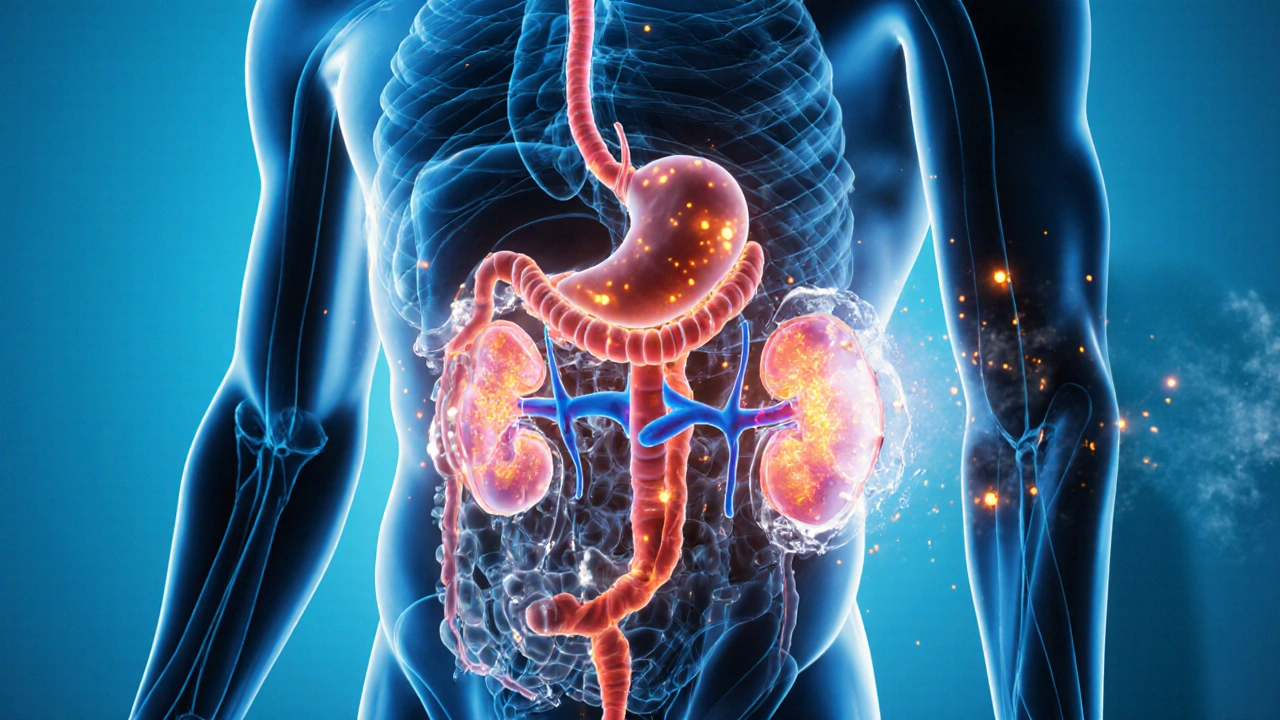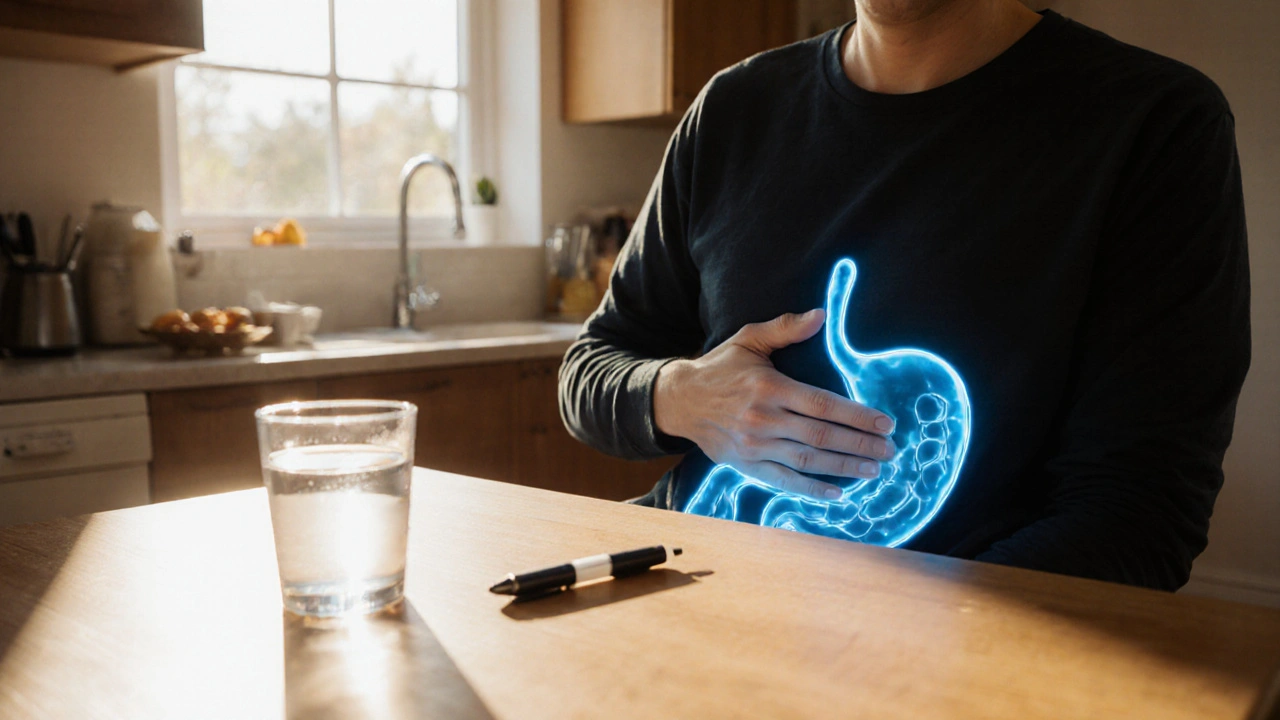Living with diabetic gastroparesis is a daily juggling act. The stomach’s sluggish emptying can crank up nausea, cause unpredictable blood sugar swings, and make staying hydrated feel like an uphill battle. Yet water and other fluids are the hidden heroes that keep blood sugar in check, prevent dangerous dehydration, and keep the gut moving (as much as it can). Below you’ll find a practical roadmap to master hydration without triggering more stomach upset.
What Is Diabetic Gastroparesis?
Diabetic gastroparesis is a condition where long‑term high blood sugar damages the vagus nerve, which controls the muscles that push food from the stomach into the small intestine. The result? Food sits in the stomach longer than it should, leading to bloating, early satiety, and erratic glucose peaks.
Because food digestion is delayed, the usual cues that tell the body when to release insulin get out of sync. This misalignment can cause both hypoglycemia (if insulin spikes early) and hyperglycemia (if carbs linger). Understanding this link is the first step toward a hydration plan that supports both the stomach and the pancreas.
Why Hydration Is a Game‑Changer
Hydration does more than quench thirst. In gastroparesis, adequate fluid intake helps thin the stomach’s contents, making it easier for the sluggish muscles to move the chyme forward. It also protects against the loss of electrolytes that can happen with vomiting or diarrhea, both common symptoms.
When you’re dehydrated, blood becomes thicker, which can raise blood sugar levels and strain the kidneys. Keeping fluids balanced helps maintain blood volume, supports kidney filtration, and can blunt the spikes in blood glucose that many diabetics dread.
Spotting the Early Signs of Dehydration
Because gastroparesis already muddles the body’s signals, dehydration can sneak up on you. Watch for:
- A dry mouth or sticky feeling on the lips
- Dark‑yellow urine (aim for pale straw‑colored)
- Headaches, dizziness, or feeling unusually tired
- Rapid heart rate (palpitations) especially after meals
- Increased hunger cravings that may actually be a thirst cue
If any of these appear alongside worsening nausea or vomiting, it’s time to boost fluid intake and possibly contact your healthcare provider.
Choosing the Right Fluids
Not all drinks are created equal when the stomach’s motility is compromised. Below is a quick comparison of the top five options for people with diabetic gastroparesis.
| Fluid | Electrolyte Content | Sugar Load (g per 250ml) | Ease of Digestion | Best Time to Take |
|---|---|---|---|---|
| Plain Water | Low | 0 | Very easy | Throughout the day, sip between meals |
| Electrolyte Solution (e.g., low‑sugar sports drink) | High (Na⁺, K⁺, Mg²⁺) | 3‑5 | Easy, isotonic | During or after meals |
| Clear Bone Broth | Moderate (Na⁺, small K⁺) | 1‑2 | Warm, soothing | Mid‑morning or mid‑afternoon |
| Coconut Water (unsweetened) | High (K⁺, Mg²⁺) | 6‑8 | Light, natural sugars | Between meals, especially if active |
| Herbal Tea (peppermint, ginger) | Low | 0‑1 | Warm, calming for nausea | After meals to aid digestion |
Aim for a mix of low‑sugar and electrolyte‑rich options. Water stays the backbone, but a splash of broth or a sip of coconut water can add flavor and minerals without spiking glucose.

Practical Tips to Boost Fluid Intake Without Worsening Nausea
- **Sip, don’t gulp.** Take 1-2oz every 5minutes rather than a big gulp. Small sips keep the stomach from feeling overloaded.
- **Use a straw.** Drawing fluid through a straw can bypass the tongue’s taste receptors, reducing the gag reflex for some people.
- **Temperature matters.** Cool (but not icy) drinks are often easier on the stomach than hot liquids, which can increase nausea.
- **Flavor lightly.** A squeeze of lemon or a dash of cinnamon can make water more appealing without adding carbs.
- **Set reminders.** Phone alarms or a water‑tracking app help you stay consistent, especially on busy days.
- **Combine fluids with protein.** A spoonful of Greek yogurt mixed with a little water can provide both hydration and a protein buffer that steadies glucose.
- **Monitor urine color.** Keep a simple chart in the bathroom to quickly gauge whether you’re on track.
These tricks keep hydration realistic for people juggling diet, medication, and a sluggish gut.
How Hydration Influences Blood Glucose Control
When you’re well‑hydrated, blood plasma volume is optimal, allowing insulin to circulate effectively. Dehydration concentrates blood glucose, making readings appear higher than they truly are. Studies from the International Diabetes Federation (2023) showed that a 2% drop in body water can raise fasting glucose by up to 0.5mmol/L.
Conversely, proper fluid balance helps the kidneys excrete excess glucose via urine, a natural safety valve. That’s why many diabetes educators stress drinking at least 8-10 cups of fluid daily - and more if you’re losing fluids through vomiting.
Building a Simple Daily Hydration Plan
Start with a baseline of 1.5L of water spread across the day. Then layer in the following:
- Morning (7‑9am): 250ml warm water with a pinch of sea salt (electrolytes) + 250ml herbal tea.
- Mid‑morning snack: 200ml coconut water.
- Before lunch (11‑12pm): 150ml clear broth.
- Lunch (1‑2pm): Sip 200ml electrolyte solution during the meal.
- Afternoon (3‑5pm): 250ml water with lemon.
- Before dinner (6pm): 150ml warm ginger tea.
- Dinner (7‑8pm): 200ml water or broth as needed.
- Evening (9‑10pm): 150ml water, check urine color before bed.
Adjust volumes based on activity level, climate (hot summer days need more), and any episodes of vomiting. Keep a simple log - a notebook or phone app - noting the type of fluid, amount, and how you felt afterwards.
When to Seek Professional Help
If you notice any of these red flags, call your diabetes care team or visit urgent care:
- Persistent vomiting for more than 24hours
- Signs of severe dehydration: dizziness, fainting, rapid heartbeat
- Blood glucose consistently above 300mg/dL despite adherence to medication
- Unexplained weight loss or severe abdominal pain
- Kidney function tests showing elevated creatinine
Early intervention can prevent hospital admissions and keep your gastroparesis manageable.

Frequently Asked Questions
Can I drink coffee if I have diabetic gastroparesis?
Coffee can stimulate stomach acid, which may worsen nausea in some people. If you enjoy it, limit to a single small (about 100ml) cup and pair it with a sip of water. Monitor how your stomach reacts and adjust accordingly.
Is it okay to add sugar substitutes to my drinks?
Most non‑nutritive sweeteners (stevia, erythritol) don’t raise blood glucose, but they can cause bloating for some sensitive guts. Test a small amount first; if you notice extra gas, stick to plain fluids.
How much fluid should I aim for if I’m exercising?
Add roughly 500ml (about 2 cups) of electrolyte‑rich fluid for every hour of moderate activity, on top of your baseline plan. Warm climates may require an extra 250ml per hour.
Why does dehydration cause my blood sugar to rise?
Less water in the bloodstream makes glucose concentrations appear higher, and the kidneys can’t flush excess sugar as efficiently. Staying hydrated dilutes glucose and helps kidneys excrete the surplus.
What if I can’t keep any fluid down after meals?
Try sipping very small amounts (1‑2oz) every 5minutes, and consider using a thickened fluid (adding a teaspoon of maltodextrin) to stay hydrated longer. If vomiting persists for more than 24hours, seek medical care for possible IV hydration.





Garrett Gonzales
October 5, 2025 AT 03:02Targeting the osmolar balance of ingested fluids can attenuate gastric dysmotility by reducing chyme viscosity. When you ingest a low‑glycemic isotonic solution, the sodium‑glucose cotransporter activity in the small intestine remains optimized, which indirectly supports vagal tone. Moreover, adequate potassium replenishment counters the hypokalemic spikes that exacerbate delayed gastric emptying. Aligning fluid timing with post‑prandial insulin peaks also minimizes the risk of hyperosmolar excursions in the bloodstream. In practice, a 250 ml electrolyte drink containing ~30 mmol/L Na⁺ and ~20 mmol/L K⁺ taken during meals yields measurable improvements in gastric emptying rates.
Aman Deep
October 5, 2025 AT 11:22🌊 sipping water feels like a gentle river flowing through a quiet desert 🏜️ it cools the fire of nausea and steadies the sugar tide 🌟 tiny sips are blessings they whisper to the stomach 🤲 keep a straw handy it’s like a secret tunnel for the liquid 🌀
Herman Bambang Suherman
October 5, 2025 AT 19:42Start each day with a pinch of sea salt in warm water to jump‑start electrolyte balance.
Meredith Blazevich
October 6, 2025 AT 04:02When the gut feels like a clenched fist, a soothing cup of ginger tea can be the gentle hand that loosens the grip. The fragrant steam not only calms nausea but also signals the vagus nerve to resume its rhythmic march. Pair that with a splash of lemon and you’ve crafted a tiny ritual that whispers, “You’re okay, we’ll get through this.” Consistency is the hero here; the body learns to expect relief and responds in kind. Remember, every sip is a small victory against the chaos of gastroparesis.
Nicola Gilmour
October 6, 2025 AT 12:22Keep a water bottle within arm’s reach; the visual cue alone nudges you to sip. Even 8 oz every hour adds up to the daily target. Celebrate each milestone – you’ve earned it.
Darci Gonzalez
October 6, 2025 AT 20:42Don’t let the scale dictate your mood 😊 a steady stream of clear broth fuels both hydration and courage 🌱 remember, every small sip builds momentum toward bigger health wins.
Marcus Edström
October 7, 2025 AT 05:02Adding a modest amount of magnesium to your electrolyte mix can further smooth muscle contractions in the stomach wall.
Val Vaden
October 7, 2025 AT 13:22Looks like you’re overcomplicating a simple thing – just drink water.
kirk lapan
October 7, 2025 AT 21:42While the poetic imagery of rivers and deserts is charming it does not replace the physiological imperatives that govern fluid kinetics. The human body operates under the laws of thermodynamics; each sip contributes to plasma osmolality and renal filtration rates. Ignoring these fundamentals in favor of metaphor can lead to suboptimal hydration strategies. For instance, the sodium‑potassium gradient is crucial for cellular depolarization, which in turn influences gastric smooth muscle activity. A deficiency in sodium can exacerbate nausea through altered enteric nervous system signaling. Moreover, the gastro‑colic reflex is sensitive to volume cues, so consistent fluid intake mitigates erratic gastric emptying. Studies published in J. Diabetes Res. have demonstrated that participants who adhered to a regimented electrolyte protocol experienced a mean reduction of 0.7 mmol/L in fasting glucose. This is not a trivial number when you consider long‑term glycemic control. Additionally, the renal threshold for glucose reabsorption can be modulated by hydration status, reducing glucosuria episodes. It is also worth noting that low‑grade dehydration can elevate cortisol, further destabilizing blood sugar. Consequently, the recommendation to sip 200 ml of isotonic solution every two hours is grounded in empirical evidence. Forgetting to account for the glycemic index of the fluids themselves can introduce hidden carbs that spike glucose. A careful selection of low‑sugar sports drinks, combined with plain water, provides both electrolytes and minimal caloric load. Finally, consistent hydration supports mucosal integrity, reducing the risk of ulcerative complications in gastroparesis patients. In sum, the poetic approach may inspire but should be supplemented by rigorous, evidence‑based protocols.
Landmark Apostolic Church
October 8, 2025 AT 06:02Imagine each droplet as a quiet mantra, a pause that aligns body and mind in the endless dance of digestion. When we honor the stillness between sips, the stomach perceives less chaos and more rhythm.
Andy Jones
October 8, 2025 AT 14:22Oh sure, because a “gentle hand” will magically fix gastric inertia – next you’ll tell us to hug our pancreas.
Kevin Huckaby
October 8, 2025 AT 22:42Actually, keeping a bottle nearby is overrated 😒 the real freedom comes from ignoring schedules and listening to your gut’s own timing 🌶️🚀
Brandon McInnis
October 9, 2025 AT 07:02Your reminder about celebrating small victories resonates deeply; each mindful sip is a stanza in the epic poem of recovery, and together they compose a symphony of resilience.